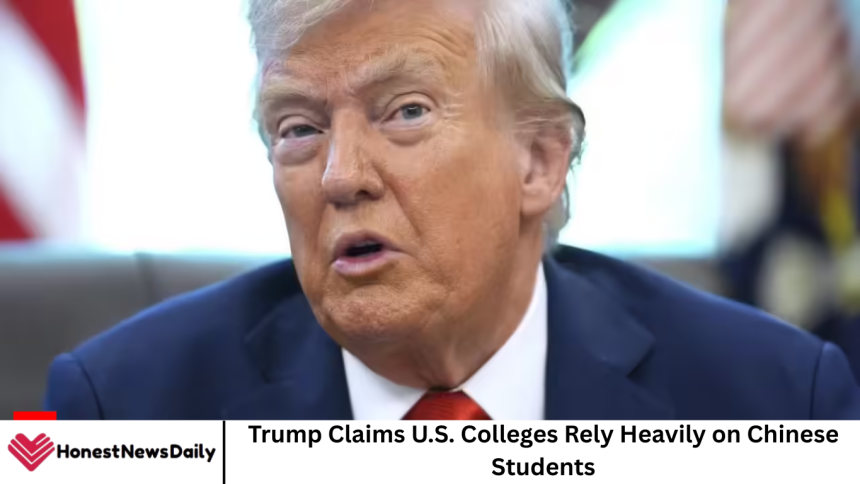In a recent statement that sparked widespread debate, former President Donald Trump asserted that U.S. colleges would face significant financial and institutional struggles without Chinese students. His claim touches on the complex intersection of education, immigration, economics, and geopolitics.
While Trump has often taken a hardline stance on China, this statement diverges by acknowledging the vital role Chinese students play in sustaining American higher education. But is this claim accurate? How deeply integrated are Chinese students in U.S. academia, and what are the consequences if their numbers decline?
This article takes a deep dive into Trump’s claim, explores the data behind international student enrollment, examines U.S.-China educational ties, and looks at the future of globalized education in an increasingly nationalistic era.
More Read: Taylor’s Engagement: What We’ve Learned and Travis’s Dad’s Revelations
A Look at the Numbers: Chinese Students in U.S. Colleges
Chinese students make up the largest group of international students in the United States. According to the Institute of International Education (IIE):
- In the 2022–2023 academic year, over 289,000 Chinese students were enrolled in U.S. institutions.
- That’s nearly 30% of all international students.
- Chinese students contributed approximately $12 billion to the U.S. economy through tuition, housing, and related expenses.
They are not just present in vast numbers; they are also concentrated in key academic areas such as STEM (Science, Technology, Engineering, Mathematics), business, and economics — fields that are vital to both research and economic productivity.
Financial Dependency: Tuition as Lifeblood
American universities, particularly public ones, have faced repeated budget cuts from state legislatures over the past decade. To make up for lost funding, many schools have:
- Increased tuition for out-of-state and international students.
- Aggressively recruited students from countries like China, where families are often willing to pay full tuition fees.
While domestic students may receive scholarships or financial aid, Chinese students usually pay full price, making them crucial for a school’s bottom line. For example:
- The University of Illinois at Urbana-Champaign at one point took out an insurance policy on the tuition revenue from Chinese students.
- Schools such as Purdue, Michigan, and UC Berkeley rely on Chinese tuition to fund faculty salaries, labs, and campus services.
Academic Impact: Diversity and Research Contributions
Aside from financial benefits, Chinese students contribute significantly to the academic reputation and research output of U.S. colleges.
- Graduate Programs: Many STEM doctoral programs would not be viable without Chinese applicants. They are often top performers, publishing in high-impact journals and contributing to innovation.
- Diversity: Chinese students add cultural diversity to campuses, preparing American students for global citizenship.
- International Rankings: U.S. universities often rank higher globally due in part to international student presence, which reflects global reach and prestige.
Without this cohort, some programs would shrink or vanish, and schools would lose global competitiveness.
Political Tensions and Visa Policies
Trump’s comment arrives against a backdrop of increasingly strained U.S.-China relations, especially under his own administration. During his presidency, he implemented:
- Visa restrictions for Chinese graduate students in sensitive tech areas.
- Accusations of espionage involving researchers from China.
- Rhetoric suggesting Chinese influence on campuses was a national security concern.
This created a climate of fear and uncertainty for Chinese applicants and current students. As a result:
- Chinese enrollment dropped slightly during the Trump years.
- Some students turned to other countries like Canada, the UK, and Australia for education.
Despite that, Trump’s recent statement seems to acknowledge their economic and academic importance, revealing a contradiction between policy and recognition.
Post-Pandemic Recovery and Shifting Trends
After the COVID-19 pandemic caused an international education slowdown, universities have been working hard to recover foreign enrollment, especially from China.
However, recent data shows:
- A growing number of Chinese families are questioning the value of an American degree.
- Geopolitical friction and rising anti-Asian sentiment have contributed to hesitancy.
- China’s domestic universities are becoming more competitive, offering alternatives.
In response, American universities are trying to diversify their international recruitment:
- Targeting students from India, Vietnam, Nigeria, and Brazil.
- Offering more online degrees and in-country partnerships.
Still, Chinese students remain the largest and most reliable source of full-tuition-paying international students.
Academic Freedom and Surveillance Concerns
Another layer of complexity involves academic freedom and surveillance concerns.
- Some U.S. lawmakers have raised red flags about Confucius Institutes — Chinese-funded cultural centers on U.S. campuses — citing propaganda risks.
- Concerns also exist about student surveillance or students being pressured to avoid criticizing the Chinese government while studying abroad.
These tensions have led to a balancing act between welcoming students and protecting campus integrity.
The Path Forward: Rethinking International Education
Trump’s claim, though controversial, does shine a spotlight on the fragile structure of American higher education. As reliance on Chinese students becomes clearer, colleges must consider long-term strategies:
- Invest in domestic affordability to reduce over-dependence on international tuition.
- Build stronger global partnerships beyond just Chinese pipelines.
- Foster cultural exchange while protecting academic values.
- Stabilize visa pathways and reduce uncertainty for applicants.
The challenge is to maintain global academic leadership without sacrificing security or values.
Frequently Asked Question
Are Chinese students the largest group of international students in the U.S.?
Yes. Chinese students consistently rank as the largest international student population in the U.S., comprising around 30% of the total foreign student body.
Why are Chinese students so important to U.S. colleges?
They pay full tuition, contribute to high-demand academic fields like STEM, and enhance campus diversity. Their financial input helps support university budgets and research programs.
Did Trump support Chinese students during his presidency?
Trump’s administration enacted stricter visa policies and scrutinized Chinese academic ties. His recent comments about their importance appear to contrast with his past actions.
How much money do Chinese students contribute to the U.S. economy?
Estimates suggest they contribute over $12 billion annually through tuition and living expenses, supporting thousands of jobs in education and surrounding communities.
Are U.S. colleges too dependent on Chinese enrollment?
Many analysts and educators agree that over-reliance on a single country is risky. However, alternatives like India and Southeast Asia are still growing markets, not replacements.
Has Chinese student enrollment declined in recent years?
Yes. Political tensions, pandemic disruptions, and growing domestic options in China have led to a gradual decline. However, Chinese students still represent a significant portion of enrollments.
What steps are universities taking to diversify their international student body?
They are expanding recruitment in countries like India, Brazil, Nigeria, and Vietnam. Some are also developing satellite campuses and online programs to reach global students directly.
Conclusion
Trump’s assertion that U.S. colleges rely heavily on Chinese students is grounded in financial and enrollment realities. While his comments may seem at odds with his previous policies, they highlight a truth that higher education institutions have known for years — Chinese students play an indispensable role in sustaining American academia, both financially and intellectually. Yet the relationship is now in flux, affected by political pressures, cultural shifts, and post-pandemic recovery. For U.S. colleges, the path forward involves embracing global diversity while investing in resilience, diplomacy, and education reform.







